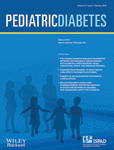Increased levels of circulating arginase I in overweight compared to normal weight adolescents
Abstract
Background and Aims
Overweight and the metabolic syndrome have become major problems, especially in children and adolescents. Obesity at a young age increases the risk for cardiovascular diseases and diabetes mellitus later in life. An early event in the development of cardiovascular disease is endothelial dysfunction which is found in obese young individuals. Increased activity of the enzyme arginase has been described as a central mechanism for endothelial dysfunction, especially in patients with diabetes mellitus. The aim of the study was to determine plasma levels of arginase in overweight adolescents.
Methods
Sixty-six male German adolescents (age: 15.2 ± 1.1 years old) were included. Thirty-one of them were overweight (>90th age-specific weight percentile). Plasma arginase I and tumor necrosis factor alpha (TNFα) were determined. In addition, clinical data were recorded and anthropometrical measurements of obesity were performed.
Results
Overweight adolescents had a higher systolic blood pressure, lower high-density lipoprotein and increased levels of high-sensitive C-reactive protein (CRP). Circulating arginase I was elevated in overweight adolescents (95.8 ± 68.2 ng/ml) compared to normal weight adolescents (39.3 ± 26.9 ng/ml, p < 0.001) and correlated with markers of obesity. There was no difference between the two groups regarding TNFα.
Conclusions
We demonstrate that arginase I levels are increased in obese adolescents. Knowing the important role for arginase in endothelial dysfunction, elevated levels of arginase I may represent a link between obesity, endothelial dysfunction and related comorbidities.




